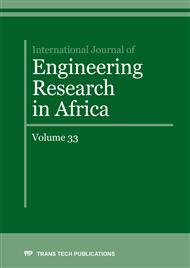[1]
P.S. Georgilakis and N.D. Hatziargyriou, Optimal Distributed Generation Placement in Power Distribution Networks: Models, Methods, and Future Research, IEEE Transactions on Power Systems, 28(3), (2013), 3420-3428.
DOI: 10.1109/tpwrs.2012.2237043
Google Scholar
[2]
S. S. Ramalakshmi, Optimal siting and sizing of distributed generation using fuzzy-EP, Recent Advancements in Electrical, Electronics and Control Engineering (ICONRAEeCE), Sivakasi, (2011), 470-477.
DOI: 10.1109/iconraeece.2011.6129770
Google Scholar
[3]
S. N. GopiyaNaik, D. K. Khatod and M. P. Sharma, Analytical approach for optimal siting and sizing of distributed generation in radial distribution networks, IET Generation, Transmission and Distribution, 9(3), (2015), 209-220.
DOI: 10.1049/iet-gtd.2014.0603
Google Scholar
[4]
M. Arumuga, et al., Application of self-adaptive differential evolution algorithm for optimal placement and sizing of renewable DG sources in distribution network including different load models, International Journal of Advanced Engineering Technology, VII(I) , (2016).
Google Scholar
[5]
M. Mardaneh and G.B. Gharehpetian, Siting and sizing of DG units using GA and OPF based technique, IEEE Region 10 Conference, (2004), 331-334.
DOI: 10.1109/tencon.2004.1414774
Google Scholar
[6]
U.R. Babu, V.K. Reddy and S. Tarakalyani, Modified GA for optimal DG allocation and sizing, Electrical, Electronics, Signals, Communication and Optimization (EESCO), Visakhapatnam, (2015), 1-4.
DOI: 10.1109/eesco.2015.7253775
Google Scholar
[7]
A. Tah and D. Das, Novel analytical method for the placement and sizing of distributed generation unit on distribution networks with and without considering P and PQV buses, International Journal of Electrical Power and Energy Systems, 78, (2016).
DOI: 10.1016/j.ijepes.2015.12.009
Google Scholar
[8]
G.J. Martín and A.J. Mena, Optimal distributed generation location and size using a modified teaching–learning based optimization algorithm, International Journal of Electrical Power and Energy Systems, 50, (2013), 65-75. .
DOI: 10.1016/j.ijepes.2013.02.023
Google Scholar
[9]
S. Sharma, S. Bhattacharjee and A. Bhattacharya, Optimal location and sizing of DG to minimize loss of distribution system using SIMBO-Q method, Control, Instrumentation, Energy and Communication (CIEC), Calcutta, (2014), 340-344.
DOI: 10.1109/ciec.2014.6959106
Google Scholar
[10]
J. J. Jamian et al., Optimum multi DG units placement and sizing based on voltage stability index and PSO, 2012 47th International Universities Power Engineering Conference (UPEC), London, (2012), 1-6.
DOI: 10.1109/upec.2012.6398458
Google Scholar
[11]
R. Syahputra, I. Soesanti and M. Ashari, Performance Enhancement of Distribution Network with DG Integration Using Modified PSO Algorithm, Journal of Electrical Systems, 12(1) , (2016), 1-19.
Google Scholar
[12]
P. Alinezhad, O.Z. Bakhoda and M.B. Menhaj, Optimal DG placement and capacity allocation using intelligent algorithms, Fuzzy and Intelligent Systems (CFIS), 2015 4th Iranian Joint Congress on, Zahedan, (2015), 1-8.
DOI: 10.1109/cfis.2015.7391657
Google Scholar
[13]
M. Gandomkar, M. Vakilian and M. Ehsan, Optimal distributed generation allocation in distribution network using Hereford Ranch algorithm, International Conference on Electrical Machines and Systems, Nanjing, 2, (2005), 916-918.
DOI: 10.1109/icems.2005.202678
Google Scholar
[14]
E.S. Ali, S.M. Abd Elazim and A.Y. Abdelaziz, Ant Lion Optimization Algorithm for optimal location and sizing of renewable distributed generations, Renewable Energy, 101, (2017), 1311-1324.
DOI: 10.1016/j.renene.2016.09.023
Google Scholar
[15]
K. Prakash and M. Sydulu, Topological and Primitive Impedance based Load Flow Method Computer Engineering, Iranian Journal of Electrical and Computer Engineering, 10(1), (2011), 10-18.
Google Scholar
[16]
A. Rashid, Voltage Stability Analysis with High Distributed Generation (DG) Penetration, Ph.D. Thesis, University of Waterloo, (2012).
Google Scholar
[17]
M. Charkravorty and D. Das, Voltage Stability-Analysis of Radial Distribution Networks, Electrical Power and Energy Systems, 23, (2001), 129-135.
DOI: 10.1016/s0142-0615(00)00040-5
Google Scholar
[18]
A. Hajizadeh and E. Hajizadeh, PSO-based planning of distribution systems with distributed generations, International Journal of Electrical and Electronics Engineering, 2(1), (2008), 33-38.
Google Scholar
[19]
U. Eminoglu and M.H. Hocaoglu, A voltage stability index for radial distribution networks, Universities Power Engineering Conference UPEC 2007, 42nd International, Brighton, (2007), 408-413.
DOI: 10.1109/upec.2007.4468982
Google Scholar
[20]
S. Ishwarya and P. R. Surya, ICGICT Allocation of DG for IEEE 33 Bus Systems, International Journal of Innovative Research in Computer and Communication Engineering, 2(1), (2014), 1030-1039.
Google Scholar
[21]
N. Acharya, P. Mahat and N. Mithulananthan, An analytical approach for DG allocation in primary distribution network, International Journal of Electrical Power and Energy Systems, 28(10), (2006), 669-678. .
DOI: 10.1016/j.ijepes.2006.02.013
Google Scholar
[22]
G. Naik, D.K. Khatod and M.P. Sharma, Optimal allocation of distributed generation in distribution system for loss reduction, In Proc. IACSIT Coimbatore Conferences, India, 28, (2012), 42-46. .
Google Scholar
[23]
T. Göze and M.H. Hocaoglu, An analytical method for the sizing and siting of distributed generators in radial systems, Electric Power System Research Journal, 79(6), (2009), 912–918.
DOI: 10.1016/j.epsr.2008.12.007
Google Scholar
[24]
T. Gözel, U. Eminoglu and M.H. Hocaoglu, A tool for voltage stability and optimization (VSandOP) in radial distribution systems using Matlab graphical user interface (GUI), Simulation Modelling Practice and Theory, 16(5), (2008), 505-518.
DOI: 10.1016/j.simpat.2008.02.003
Google Scholar
[25]
M.M. Aman, et al., A new approach for optimum DG placement and sizing based on voltage stability maximization and minimization of power losses, Energy Conversion and Management, 70, (2013), 202-210. .
DOI: 10.1016/j.enconman.2013.02.015
Google Scholar


